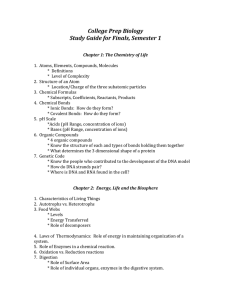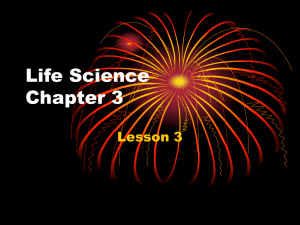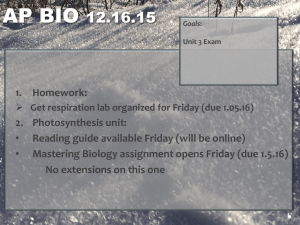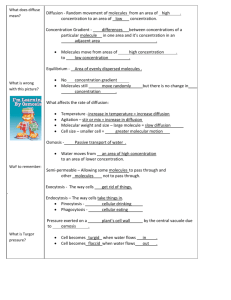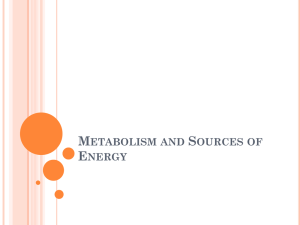Prologue: 1. Chapter 1: The Chemistry of Life
advertisement
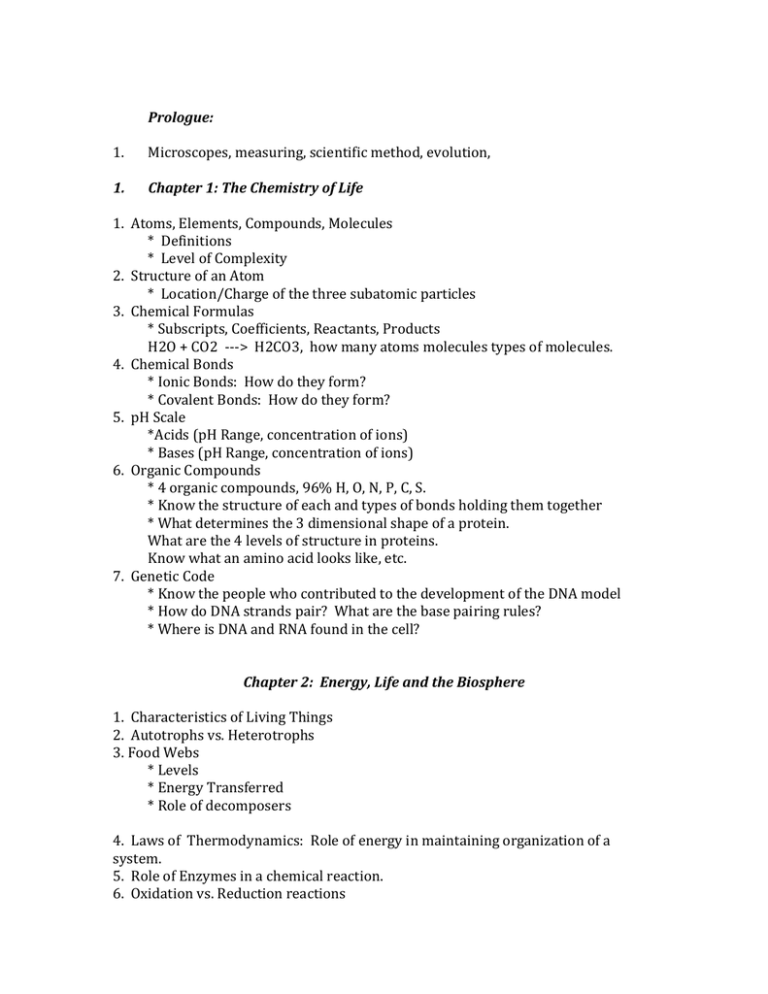
Prologue: 1. Microscopes, measuring, scientific method, evolution, 1. Chapter 1: The Chemistry of Life 1. Atoms, Elements, Compounds, Molecules * Definitions * Level of Complexity 2. Structure of an Atom * Location/Charge of the three subatomic particles 3. Chemical Formulas * Subscripts, Coefficients, Reactants, Products H2O + CO2 ---> H2CO3, how many atoms molecules types of molecules. 4. Chemical Bonds * Ionic Bonds: How do they form? * Covalent Bonds: How do they form? 5. pH Scale *Acids (pH Range, concentration of ions) * Bases (pH Range, concentration of ions) 6. Organic Compounds * 4 organic compounds, 96% H, O, N, P, C, S. * Know the structure of each and types of bonds holding them together * What determines the 3 dimensional shape of a protein. What are the 4 levels of structure in proteins. Know what an amino acid looks like, etc. 7. Genetic Code * Know the people who contributed to the development of the DNA model * How do DNA strands pair? What are the base pairing rules? * Where is DNA and RNA found in the cell? Chapter 2: Energy, Life and the Biosphere 1. Characteristics of Living Things 2. Autotrophs vs. Heterotrophs 3. Food Webs * Levels * Energy Transferred * Role of decomposers 4. Laws of Thermodynamics: Role of energy in maintaining organization of a system. 5. Role of Enzymes in a chemical reaction. 6. Oxidation vs. Reduction reactions 7. Digestion * Role of Surface Area * stomach is a ___pH the pancreas changes this to a _____ pH * Role of individual organs, enzymes in the digestive system. * Where are Carbohydrates, Proteins, and Lipids digested in the system? * what is protein digested into, carbohydrates, etc. Chapter 3: Exchanging Materials with the Environment 1. 2. 3. 4. 5. 6. Structure of the Cell Membrane. How are the phospholipids arranged? Movement of molecules across the cell membrane goes from ___ to ___ . Creating concentration Gradients is a form of potential energy. Passive Diffusion (Diffusion, Osmosis, Facilitated Diffusion) vs. Active Transport How is active transport involved in a nerve impulse. Gas Exchange * Compare respiratory system of Fish, Birds, and Humans * Role of Surface Area 7. Waste Removal * Osmosis * Ammonia, Urea, Uric Acid. What types of organisms use each, why? Human Kidney It’s Structure and Function Nephron: Structure and Function Filtration, Secretion, Reabsorption. Where does each happen in the nephron. What substances are filtered, secreted and reabsorbed? Chapter 4: Photosynthesis 1. Equation and purpose 2. Where the Two stages of photosynthesis occur. 3. Materials Used/Products made for Light reactions and Calvin Cycle 4. Colors of light absorbed by the pigment chlorophyll which gives off ____. 5. Photorespiration: Why does it happen? How does a plant prevent it? Chapter 5: Cellular Respiration 1. Equation and purpose. Why is ATP important? Where is the energy of food found. 2. Three stages of cellular respiration (Know cycle, where they happen, and products) 3. Know which reactions are synthesis [building] or decomposition reactions 4. Mitochondria: Structure and purpose. Which stages of cellular respiration happen where? 5. NAD and FAD carry __________ in cellular respiration 6. Total amount of ATP produced in each stage Chapter 6: Cell Structures and Their Functions 1. Differences between Prokaryotes and Eukaryotes 2. Developments of Microscopes 3. Parts of a Eukaryotic Cell and their Functions 4. Organization of Cells - Levels of Structure in the Biosphere Chapter 7: Transport systems 1. Structures of the human circulatory system and their functions. 2. Structure of Actin and myosin and how muscle contractions occur. 3. Blood pressure measurement. 4. Blood flow through the heart. Essay Portion of Final Exam There will be data that you graph Determine rate of reaction Products Reactants Interpret the lines and develop conclusions
